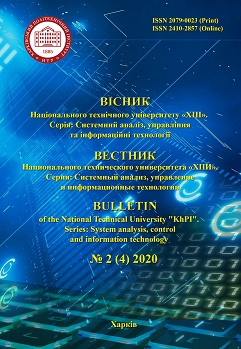DEVELOPMENT OF INFORMATION TECHNOLOGY FOR OPTIMIZING THE CONTROL OF COMPLEX DYNAMIC SYSTEMS
DOI:
https://doi.org/10.20998/2079-0023.2020.02.11Keywords:
information technology, dynamic system, complex system, information control system, mathematical model, quality index, optimization method, optimization processAbstract
The structure of information technology optimization of complex dynamic systems is developed. The structure includes a block of systems models, a module of integration methods, a block for calculating system quality criteria, a block of optimization methods, a module of data structures and a block for presenting information. A functional model of information technology is presented. The block of systems models contains models of dynamic systems – control objects, regulators, information control systems. This makes it possible to simulate information control systems of NPP power units, a quadrocopter control system, generators of electrical impulses and other dynamic systems. In the module of integration methods, methods for integrating systems of differential equations are collected: the matrix exponential method for integrating linear systems, system methods for integrating nonlinear systems, and other methods. In the block for calculating system quality criteria, programs have been created for calculating various criteria for information control systems: stability of control processes, identification of parameters, direct indexes of the quality of systems, integral quadratic estimates. The block of optimization methods has been developed. This block contains modules of methods of one-dimensional search, multivariate unconditional optimization, global search, genetic algorithms, sum of squares minimization, conditional optimization, vector optimization. To test methods, test function modules are created. These modules include test functions, their databases and testing programs. A module of common data structures has been developed. Global data structures are proposed – the structure of constant data of optimization problems and methods, the structure of the state variables of the optimization process and the structure of functions to coordinate the interaction of optimization methods. The block for presenting information for solving problems allows the optimization process to be presented in the form of tables and graphs.References
Bastrikov M. V., Ponomarev O. P. Informatsionnye technologii upravleniya [Information technologies control]. Moscow, EKSMO Publ., 2002. 391 p.
Pavlov A. A., Telenik S. F. Informatsionnye technologii i algoritmizatsiya v upravlenii [Information technologies and algorithms in control]. Kiev, Tekhnika Publ., 2002. 344 p.
Ershova N. M. Sovremennye metody teorii proektirovaniya i upravleniya sloghnymi dinamicheskimi sistemami:monografiya [Modern methods of the theory of design and control of complex dynamic systems: monograph]. Dnepropetrovsk, PRASA Publ., 2016. 272 p.
Yastrebenetskiy М. А., Vasil'chenko V. N., Vinogradov S. V. Bezopasnost' atomnykh stantsiy: informatsionnye i upravlyayushchie sistemy [Nuclear power plant safety: information and control Systems]. Kiev, Tekhnika Publ., 2004. 472 p.
Afanas'eva O. V., Golik E. S., Pervukhin D. А. Teoriya i praktika modelirovaniya sloghnykh sistem: uchebnoye posobiye [Theory and practice of modeling complex systems: Textbook]. St. Petersburg. SZTU Publ., 2005. 132 p.
Chernorutskiy I. G. Metody optimizatsii v teorii upravleniya: uchebnoye posobiye [Optimization methods in control theory: Textbook] St. Petersburg. Piter Publ., 2004. 256 p.
Besekerskiy V. A., Popov Е. P. Teoriya sistem avtomaticheskogo upravleniya [Theory of automatic control systems]. St. Petersburg. Professiya Publ., 2004. 752 p.
Izmailov А. F., Solodov М. V. Chislennye metody optimizatsii: uchebnoye posobiye [Numerical optimization techniques: Textbook]. Moscow, FIZMATLIT Publ., 2005. 304 p.
Mokhtar S. Bazaraa, Hanif D. Sherali, Shetty C. M. Nonlinear programming theory and algorithms; third edition Hoboken, New Jersey: Wiley, 2006. 853 р.
Severin V. P., Nikulina Е. N. Metody odnomernogo poiska: laborotornyy praktikum po kursu «Metody optimizatsii» [Onedimensional search methods: laboratory practice on the course "Optimization Methods"]. Kharkov, NTU "KhPI" Publ., 2013. 124 p.
Nikulina Е. N., Severin V. P., Lukinova D. А. Matematicheskie modeli dlya issledovaniya perekhodnykh reghimov yadernogo reaktora VVER-1000 serii V-320 [Mathematical models for investigation of transient regimes of VVER-1000 nuclear reactor of V-320 series]. Ядерна та радіаційна безпека [Nuclear and radiation safety]. 2018, no. 1(77), pp. 18-23.
Severin V. P., Nikulina Е. N., Lukinova D. А. Mnogokriterial'nyy sintez sistem upravleniya ehergobloka AES s bspol'zovaniem laborotorii metodov optimizatsii [Multicriteria synthesis of NPP power unit control systems using the OPTLAB optimization methods laboratory]. Vestnik Nats. tekhn. un-ta "KhPI": sb. nauch. tr. Temat. vyp.: Sistemnyy analiz, upravlenie i informatsionnye tekhnologii [Bulletin of the National Technical University "KhPI": a collection of scientific papers. Thematic issue: System analysis, management and information technology]. Kharkov, NTU "KhPI" Publ., 2015, no. 15(1124), pp. 106–111.
Downloads
How to Cite
Issue
Section
License
Copyright (c) 2020 Bulletin of National Technical University "KhPI". Series: System Analysis, Control and Information TechnologiesAuthors who publish with this journal agree to the following terms:
- Authors retain copyright and grant the journal right of first publication with the work simultaneously licensed under a Creative Commons Attribution License that allows others to share the work with an acknowledgement of the work's authorship and initial publication in this journal.
- Authors are able to enter into separate, additional contractual arrangements for the non-exclusive distribution of the journal's published version of the work (e.g., post it to an institutional repository or publish it in a book), with an acknowledgement of its initial publication in this journal.
- Authors are permitted and encouraged to post their work online (e.g., in institutional repositories or on their website) prior to and during the submission process, as it can lead to productive exchanges, as well as earlier and greater citation of published work (See The Effect of Open Access).


